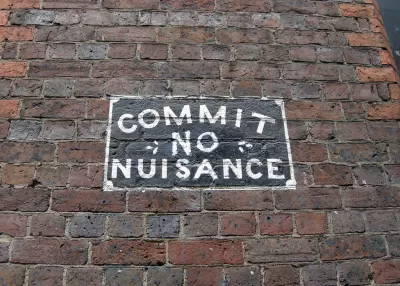Examining the growing demand for alley homes in Washington, D.C.—where alleys were once considered "evil."

Developers and property owners in Washington, D.C. are responding to a wave of interest in alley living—a residential arrangement once considered a sign of squalor is now considered unique and urban. Alley dwellings are NOW priced at upper levels of the housing market.
Mary Hui provides in-depth coverage of the trend in the D.C. real estate market:
While the rehabilitation of vacant alley buildings into residential homes is not new to the city, the recent flurry of activity involving alleys — both from developers like Ruppert and individuals like Wing — points to a growing public consciousness of all that an alley can hold.
Hui presents the growing popularity of alley residential dwellings as a symptom of the affordable housing crisis. "Alley dwellings, experts say, help by creating housing options in existing, underused space," writes Hui.
Alley programs are becoming more common in other cities, too. "In Austin, the Alley Flat Initiative has identified a network of vacant and underused alleys in the city’s east, and is working to build alley flats in the residential lots facing these alleys," according to Hui.
In Denver, the Single Family Plus housing initiative "will kick off next spring with the goal of building 250 backyard or alley homes over five years." In Denver's case, the program is designed to build Accessory Dwelling Units (ADUs), which differ in definition from alley lot dwellings, but they reflect a similar purpose, according to Hui: "putting free space to use."
FULL STORY: Are alleys the new frontier for D.C.’s housing market?

Alabama: Trump Terminates Settlements for Black Communities Harmed By Raw Sewage
Trump deemed the landmark civil rights agreement “illegal DEI and environmental justice policy.”

Planetizen Federal Action Tracker
A weekly monitor of how Trump’s orders and actions are impacting planners and planning in America.

The 120 Year Old Tiny Home Villages That Sheltered San Francisco’s Earthquake Refugees
More than a century ago, San Francisco mobilized to house thousands of residents displaced by the 1906 earthquake. Could their strategy offer a model for the present?

In Both Crashes and Crime, Public Transportation is Far Safer than Driving
Contrary to popular assumptions, public transportation has far lower crash and crime rates than automobile travel. For safer communities, improve and encourage transit travel.

Report: Zoning Reforms Should Complement Nashville’s Ambitious Transit Plan
Without reform, restrictive zoning codes will limit the impact of the city’s planned transit expansion and could exclude some of the residents who depend on transit the most.

Judge Orders Release of Frozen IRA, IIJA Funding
The decision is a victory for environmental groups who charged that freezing funds for critical infrastructure and disaster response programs caused “real and irreparable harm” to communities.
Urban Design for Planners 1: Software Tools
This six-course series explores essential urban design concepts using open source software and equips planners with the tools they need to participate fully in the urban design process.
Planning for Universal Design
Learn the tools for implementing Universal Design in planning regulations.
Clanton & Associates, Inc.
Jessamine County Fiscal Court
Institute for Housing and Urban Development Studies (IHS)
City of Grandview
Harvard GSD Executive Education
Toledo-Lucas County Plan Commissions
Salt Lake City
NYU Wagner Graduate School of Public Service





























